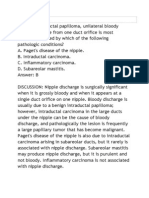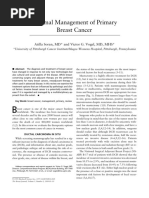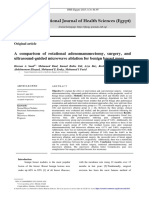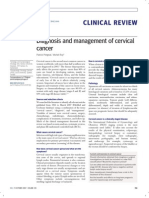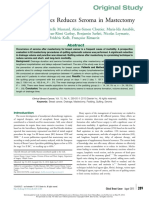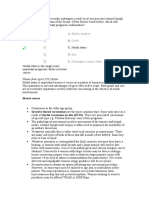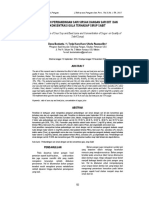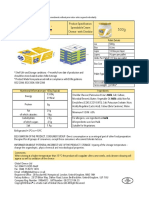Cryosurgery of Breast Cancer: Lizhi Niu, Liang Zhou, Kecheng Xu
Cryosurgery of Breast Cancer: Lizhi Niu, Liang Zhou, Kecheng Xu
Uploaded by
Katon Adi NugrohoCopyright:
Available Formats
Cryosurgery of Breast Cancer: Lizhi Niu, Liang Zhou, Kecheng Xu
Cryosurgery of Breast Cancer: Lizhi Niu, Liang Zhou, Kecheng Xu
Uploaded by
Katon Adi NugrohoOriginal Title
Copyright
Available Formats
Share this document
Did you find this document useful?
Is this content inappropriate?
Copyright:
Available Formats
Cryosurgery of Breast Cancer: Lizhi Niu, Liang Zhou, Kecheng Xu
Cryosurgery of Breast Cancer: Lizhi Niu, Liang Zhou, Kecheng Xu
Uploaded by
Katon Adi NugrohoCopyright:
Available Formats
Review Article
Cryosurgery of breast cancer
Lizhi Niu1,2, Liang Zhou1,2, Kecheng Xu1,2
1
Department of Oncology, Affiliated Fuda Hospital, Guangzhou Institutes of Biomedicine and Health, Chinese Academy of Science, No. 91-93
Judezhong Road, Haizhu District, Guangzhou 510305, China; 2Guangzhou Fuda Cancer Hospital, Jinan University School of Medicine, No. 2 Tangdexi
Road, Tianhe District, Guangzhou 510305, China
Correspondence to: Lizhi Niu, MD, PhD. Guangzhou Fuda Cancer Hospital, Jinan University School of Medicine, No. 2 Tangdexi Road, Tianhe
District, Guangzhou 510305, China. Email: niuboshi1966@yahoo.com.cn.
Abstract: With recent improvements in breast imaging, the ability to identify small breast tumors is
markedly improved, prompting significant interest in the use of cryoablation without surgical excision to
treat early-stage breast cancer. The cryoablation is often performed using ultrasound-guided tabletop argon-
gas-based cryoablation system with a double freeze/thaw cycle. Recent studies have demonstrated that, as
a primary therapy for small breast cancer, cryoablation is safe and effective with durable results, and can
successfully destroy all cancers <1.0 cm and tumors between 1.0 and 1.5 cm without a significant ductal
carcinoma-in-situ (DCIS) component. Presence of noncalcified DCIS is the cause of most cryoablation
failures. At this time, cryoablation should be limited to patients with invasive ductal carcinoma <1.5 cm and
with <25% DCIS in the core biopsy. For unresectable advanced breast cancer, cryoablation is a palliation
modality and may be used as complementary for subsequent resection or other therapies.
Keywords: Breast cancer; cryoablation; cryosurgery; ductal carcinoma-in-situ
Submitted Jul 15, 2012. Accepted for publication Aug 10, 2012.
doi: 10.3978/j.issn.2227-684X.2012.08.01
Scan to your mobile device or view this article at: http://www.glandsurgery.org/article/view/992/1195
Introduction for the nonsurgical ablation of breast cancer, and these
methods include radiofrequency ablation, cryosurgery,
Breast cancer is the most common type of cancer among
laser interstitial therapy, high-intensity focused ultrasound
women in the world (other than skin cancer). Over 211,000
surgery, and focused microwave thermotherapy (3,4). Of
new cases of invasive breast cancer were diagnosed in the
these modalities, cryoablation of breast cancer has been
Unites States in 2003. The widespread screening for breast
paid great attention (4,5). Apart from treating small breast
cancer has resulted in more patients with earlier stages and cancer, cryoablation has been used for palliation of advanced
tumors less than 20 mm in size being detected (1). One breast cancer.
third of all new cancers, which are less than 10 mm, have
an excellent prognosis, with approximately a 90% survival
rate at 20 years (2), the diagnosis and treatment of breast Indication
cancer have changed rapidly in the past 2 decades, with less The selection of patients with breast cancer who undergo
invasive procedures replacing more extensive procedures. cryosurgery is based on the following considerations (6,7):
For decades, ablative techniques have been applied v The best indications of cryosurgery for breast cancer
to malignancies in the liver, lung, bone, kidney, prostate are small solitary invasive breast cancers, smaller
gland, and pancreas (3). The breast is an ideal model for than 15 mm with low density on a mammogram
ablative therapies because of its superficial location on the and discrete margins and a visible posterior wall
thorax and absence of intervening organs between it and at ultrasonography, small breast tumors are not
the skin. Several methods are presently being investigated candidates for surgery or pharmacologic therapy;
Gland Surgery. All rights reserved. www.glandsurgery.org Gland Surgery 2012;1(2):111-118
112 Niu et al. Cryosurgery of breast cancer
A B C
Figure 1 A 50 year-old-lady with infiltrating ductal carcinoma of right breast with ulceration underwent percutaneous cryosurgery
and subsequent chemotherapy, and has disease-free survival of 3 years. A. Before treatment, broken surface of tumor; B. Percutaneous
cryosurgery was performing; C. Three months after treatment, the lesion healed.
v For inflammatory carcinoma (carcinoma erysipelatodes), with a variety of probe-tip adaptors to fit the size and
which spreads rapidly, cryosurgery with the liquid shape of the tumor;
nitrogen (LN2) spraying technique is the only measure v Contact method plus spraying method: frequently
to stop the disease and salvage the patient; used safely for bulky and for widespread tumors, to
v Invasive lobular carcinoma and cancers with expedite freezing;
significant amounts of intraductal carcinoma tend to v Penetration method plus spraying method: for massive
be multifocal, with some foci too small to be seen on tumors;
current imaging, are not candidates for this treatment; v The procedure of penetration cryosurgery for breast
v Cryosurgery for anaplastic cancer may cause cancer is briefly introduced as follows (9,10).
unexpected progression of the disease, thus is The tumor is first identified by using ultrasound
contraindicated; (US) and the most convenient access to the mass was
v There should be not be any history of prior cancer determined. For local anesthesia, 2-5 mL of 1% lidocaine
in the targeted breast, no other tumors or suspicious is injected into the deeper tissues proximal to the mass
lesions, and the lymph nodes should be clinically along the expected course of the cryoprobe. Afterward,
negative; a variable number (one to two) of cryoprobes (1.4 or 1.7
v Any inoperable stage III or IV cancer, not indicated mm in diameter) are percutaneously placed directly into
for conventional surgery, and recurrent breast cancer the breast mass through a small incision and the tip was
with multiple and widespread lesions, resistant to advanced 1.0-1.5 cm beyond the distal edge of the tumor
radio/chemo/endocrine therapy; these are indications (Figure 1). Generally, lesions smaller than 15 mm could be
for cryosurgery. Goals of cryosurgery include reliably frozen with a single, centrally placed, 3-mm probe,
arresting continuous hemorrhage from an ulcerating and large lesions require multiple probes. Placement
tumor, reducing malodorous discharge, reduction in of probes within the tumor is confirmed by using US
the tumor bulk, and alleviating intractable pain. to ensure symmetrical placement of the probe prior to
activation of the cryoablation system. Each cryoprobe is
cooled to 160 C for 10-15 minutes. The cryoablation
Technology
procedure consists of two freeze-thaw cycles. With real-
The following kinds of cryosurgery techniques are used for time ultrasound, the freeze ball can be seen encompassing
breast cancer (7,8): the tumor because there exists a highly echogenic interface
v Penetration method, namely percutaneous cryosurgery, between frozen and unfrozen tissue. Because the ice ball
is the best of all of the cryosurgical techniques for forms more like an oval than a ball; that is, it is longer in
various size of tumors; the longitudinal plane along the length of the probe, the
v Contact method: the most frequently used and safe, diameter of the ice-ball in the longitudinal and transverse
Gland Surgery. All rights reserved. www.glandsurgery.org Gland Surgery 2012;1(2):111-118
Gland Surgery, Vol 1, No 2 August 2012 113
planes is measured during each freeze-thaw cycle to carcinoma. The 5 tumors <16 mm showed no evidence
ensure appropriate width and length so that the ice-ball of invasive cancer. However, two of these five had ductal
encompasses the cancer with an additional safe border of carcinoma-in-situ (DCIS) in the surrounding tissue. In the 11
at least 5 mm. tumors >23 mm, histologic examination revealed incomplete
If the ice-ball is too close to skin, saline may be injected necrosis. The results showed that the invasive components
into the breast tissue between tumor and skin to maintain of small tumors can be treated using cryotherapy, but that
a suitable distance. Alternatively, room temperature saline DCIS components may not be detected before ablation and
or water can be dripped directly onto the skins surface to represent a challenging problem.
protect it (6). Roubidoux et al. (14) reported that 9 patients were treated
Percutaneous cryoablation for breast cancer is also with US-guided tabletop argon gas-based cryoablation
performed under guidance of near-real-time open- system. Mean cancer size was 12 mm. Tumor sites were
configuration MR system. excised at lumpectomy 2-3 weeks after cryoablation. Seven
It is specially noted that once the tumor tissue has been (78%) of 9 patients had no residual cancer. One patient had
destroyed, tumor markers cannot be reliably assessed. a small focus of invasive cancer; one had extensive multifocal
Therefore, core biopsy of the breast cancer to determine ductal carcinoma in situ. No residual invasive cancer occurred
the presence of estrogen and progesterone receptors, in tumors 17 mm or smaller or in cancers without spiculated
HER-2/neu, and markers of proliferation, apoptosis, margins at US. After cryoablation, there was increased
differentiation, and cell regulation is a prerequisite for the echogenicity at US and increased density at mammography. The
ablative techniques (6). study shows that tumor size <16 mm, increased mammographic
density, and US characteristics without spiculated margins may
suggest complete necrosis of the tumor.
Clinical results
Sabel et al. (15) reported 29 patients with primary
Small breast cancer invasive breast cancer less than 20 mm who underwent
ultrasound-guided cryosurgery with a tabletop argon-
In 1985, Rand et al. (11) made the first reported a
gas-based cryosurgical system. All cancers <1.0 cm were
77-year-old woman with a 1 by 2 cm palpable mass,
successfully destroyed. For tumors between 1.0 and 1.5 cm,
who underwent cryosurgery under US guidance, and
this success rate was achieved only in patients with invasive
the tumor was then resected. Histopathologic analysis
ductal carcinoma without a significant DCIS component.
revealed no viable tumor cells. The patient had disease- Morin et al. (16) reported that under the guidance of
free during 2-year follow-up. In 1997, Staren (5) reported open-configuration MR system, percutaneous cryosurgery
a 76-year-old lady with two foci of infiltrating lobular was performed in 25 patients with operable invasive breast
carcinoma who received percutaneous cryosurgery. Core carcinoma, 4 weeks prior to their scheduled mastectomy.
needle biopsy at 4 and 12 weeks postablation revealed All tumoral tissues included in the cryogenic ice-ball were
tissue necrosis, inflammatory cells, and cellular debris destroyed, with no viable histologic residues. Ablation was
but were negative for persistent tumor. This is the only total in 13 of the 25 tumors treated.
human example of the natural history of cryoablated In Fuda Cancer Hospital Guangzhou, Niu et al. (17)
breast carcinoma because nearly all ablation studies are had treated 27 patients with small solitary invasive breast
coupled with postprocedure resection. cancers using US-guided cryoablation. Tumor proven by
Stocks et al. (12) reported 11 patients with invasive core biopsy had median of 13 mm with range of 8-25 mm
ductal carcinoma who underwent cryoablation and then in size. All 27 patients underwent lumpectomy an average of
the tumors were excised within 1 to 3 weeks. The tumors 14 days after the cryoablation (8-35 days). Twenty-two of 27
ranged from 7 to 22 mm and averaged 13 mm. Ten of the patients had axillary staging by intraoperative lymph node
11 tumors were completely ablated. In one case residual mapping and sentinel lymph node biopsy performed at the
malignant cells were seen at the border of the ablation zone. same time. Four (14.8%) patients had a positive sentinel
This study highlights the challenge of eradicating in situ lymph node. No viable invasive cancer was discovered in
carcinoma with ablative therapy. 23 (85.2%) of the 27 patients according to histological
Pfleiderer et al. (13) further investigated potential of findings of specimen from lumpectomy. A DCIS which was
cryosurgery in the treatment of invasive and in situ breast present within the normal tissue surrounding the cryozone
Gland Surgery. All rights reserved. www.glandsurgery.org Gland Surgery 2012;1(2):111-118
114 Niu et al. Cryosurgery of breast cancer
Table 1 The results of cryosurgery for 42 patients with advanced breast cancer
Survival (%)
Therapy Cases
1-year 2-year 3-year 4-year
Cryosurgery + Chemotherapy 15 68 63 56 47
Cryosurgery + Chemotherapy + Endocrine therapy 27 74 65 51 44
Total 42 72 64 53.5 45.5
A B C
Figure 2 A 43-year-old lady with undifferentiated adenocarcinoma of right breast, stage IV, received percutaneous cryosurgery and
subsequent chemotherapy, and had disease-free survival of 29 months. A. Before cryosurgery, CT showed a mass of 6 by 7 cm in size; B.
One month after cryosurgery, the mass on CT was decreased in size; C. PET-CT showed no metabolic activity of cryotreated mass at three
months after cryosurgery.
was discovered in an additional four patients (14.8%), in Discussion
whom two patients had a small focus of lesion and two cases
From surgical resection to ablation
had multifocal lesions. Among 11 patients whose tumors
<15 mm in size successfully underwent cryoablation, with During the last 20 years, the conventional treatment for
no residual invasive or intraductal carcinoma, whereas the breast cancer has shifted from radical mastectomy to breast
tumors in 4 patients with residual DCIS had 15, 21, 21, and conservation through the combined use of lumpectomy
25 mm in size, respectively. and radiation therapy. It is conclusively demonstrated that
mastectomy and lumpectomy have long-term efficacy
for the appropriate candidate (19,20). The reduced
Advanced breast cancer
psychological and cosmetic impact of lumpectomy in
For advanced breast cancer, cryosurgery can improve comparison to radical mastectomy makes it a much more
patients condition and prolong survival. Korpan (7) showed desirable option (21).
52 patients with breast cancer, including 10 primary Although lumpectomy is not a major operation, it still
advanced and 42 recurrent, who underwent cryosurgery. is a surgical procedure. Compared with surgical resection,
Three- and four-year survival were 40%. This figure is not ablative therapies have a number of benefits, including
disappointing given the patients severe condition. (I) breast tumor ablation without surgical excision may
From July to Dec 2005, 42 patients with advanced breast be a less morbid procedure without sacrificing cancer
cancer underwent percutaneous cryosurgery in Fuda Cancer control; (II) the therapy can be performed in the office
Hospital at Guangzhou, China. Of 42 patients, 15 received or ambulatory surgery setting with local anesthesia; (III)
chemotherapy and 27 chemo/endocrine therapy. Overall because the technique does not resect native tissue, it is
1-, 2-, 3-, and 4-year survival are 72%, 64%, 53% and less disruptive to the contour of the breast, ablated tissues
45%, as shown in Table 1, and typical cases were illustrated remain in the breast for resorption over time, hence, this
in Figures 1,2,3 (18). may improve the cosmetic outcome; (IV) these percutaneous
Gland Surgery. All rights reserved. www.glandsurgery.org Gland Surgery 2012;1(2):111-118
Gland Surgery, Vol 1, No 2 August 2012 115
A B
C D
Figure 3 A 54-year-old female, with undifferentiated carcinoma of left breast received percutaneous cryosurgery and the subsequent
resection of mass and chemotherapy, and had progression-free survival of 26 months. A. Before treatment, tumor had ulcerated; B. Before
treatment, CT showed the mass of left-low quadrant of left breast; C. After resection of cryotreated mass; D. The specimen of resected mass
shows complete necrosis of tissue proven by histology
techniques do not require incisions, which may speed recovery death can occur as soon as 2 minutes (23). The large and
time (4,5). However, ablative techniques have the drawback rapid increases in temperature result in almost instantaneous
of not providing tissue for pathological examination. As a melting of the lipids in the cellular membrane and protein
consequence, one cannot be certain that the entire lesion denaturation, causing instant necrosis. However, the
is ablated. Moreover, some tumor characteristics like the creation of a confluent volume of necrosis with a heat-based
microscopic size, grade, hormonal receptor status and ablation technology is technically challenging. Breast tissue
margin status are not available. is composed of both fatty and stromal elements. These
different tissues have different thermal properties (i.e., heat
capacity and thermal impedance) which may lead to heating
Comparison between heat-based ablation and cryoablation
that is not predictable or symmetrical. Also, blood flow will
Compared with ablation technologies which raise tissue remove heat from the tissue being treated, which can also
temperature, cryosurgery appears more rational (22). There cause irregular ablation zones (24,25), and the uneven size
are following theoretical advantages of cryoablation: of ablation volume can lead to over or under treatment (26).
Firstly, in heat-based ablation, the degree of thermal Several studies have shown residual viable cancer following
injury depends on temperature and duration of exposure. radiofrequency ablation (27,28).
The time necessary for cell death decreases as temperature During cryoablation, the ablation zone is literally frozen
increases, At 42 C, tissue injury occurs, but complete cell in place. No blood flow occurs into or out of an ice-ball. In
necrosis may take several hours to achieve, and at 51 C, cell addition, the ice-ball is always in a quasi- equilibrated state,
Gland Surgery. All rights reserved. www.glandsurgery.org Gland Surgery 2012;1(2):111-118
116 Niu et al. Cryosurgery of breast cancer
which ensures both a symmetric ice-ball and symmetric invasive ductal cancers <1.5 cm and with <25% DCIS
temperature distribution within the ice-ball, resulting in a on the core biopsy. Some breast cancers, such as invasive
symmetric volume of confluent ablation (29). lobular carcinoma and significant intraductal carcinoma,
Secondly, heat ablation often causes pain during and tend to be multifocal and may include foci too small to be
after the procedure (30). Consequently, sedation or general detected through imaging, making them unsuitable for
anesthesia is often required with heat- based ablation. in situ ablation. Tumors that present with more than the
A significant volume of anesthetic may alter the heating most minimal degree of microcalcification should also be
characteristics of the device and the biologic effect it excluded, since the extent of these lesions on mammography
induces (26). often can not be detected (5).
Pain, as observed with heat-based ablation, is usually not It is believed that as diagnostic tools improve, specifically
a problem during or after cryoablation, because the natural those such as MRI and PET, may allow for accurate
analgesic effect of cold is a natural analgesic (31). mapping of all cancer and DCIS within the breast. In
Thirdly, another drawback of heat-based ablation is the addition, the improvement of cryoablation procedure
difficulty of real-time guidance for operative procedure with is important. Use of multiple cryoprobes can partially
ultrasound, which may impair the targeting precision (26). overcome the pitfall of single cryoprobe ablation (29).
In contrast, during cryoablation, ultrasound shows the
proximal edge of the ice-ball appearing as a clearly visible
Follow-up after cryoablation
hyperechoic rim, provides an excellent guidance at the
boundary between frozen and unfrozen tissue. Since the tissue is not excised, complete pathology of the
Lastly, for prevention of skin injury, at least a 10-mm margins cannot be achieved, requiring vigilant follow-up
separation of the tumor edge and the skin surface is to show if there is residual or recurrent cancer in untreated
required. With cryoablation, it is possible to inject saline tissue of the breast. However, it is not yet known what
(while monitoring with real-time ultrasound) between the the optimal guiding option for patient is who underwent
tumor and the skin, increasing their separation. This allows cryoablation. Serial radiological follow-up should be able to
for the treatment of tumors close to the skin (5). However, detect residual growth or recurrent cancer. The combined
with heat-based ablation, injection of saline may alter the use of imaging technologies such as mammography,
thermic effect. ultrasound, gadolinium-enhanced MRI, and PET may be
helpful to decrease misdiagnosis of cancer recurrence (5).
Patient selection of cryoablation
Use of cryoablation for advanced breast cancer
Patient selection is key to successful cryoablation. DCIS
represents a special problem, the presence of DCIS at There are few data of cryoablation for advanced breast
the margin of the cryoablation zone results in incomplete cancer. For such cases whose tumors cant be resected,
tumor necrosis, in other words, DCIS may be a relative cryosurgery seems to be a wise choice. Our primary
contraindication to cryotherapy. However, even using experience is encouraging. As a cytoreductive technique,
MR imaging, DCIS lesions are only detected in 60-70% cryoablation can provide a basis for subsequent resection
of patients with breast cancer (15). This fact makes it and other modalities such as chemotherapy, radiation and
impossible to include DCIS components of invasive molecular targeted therapy.
carcinomas in the therapy planning for such cases. It is suggested that the immune system of the host
Generally, DCIS is often seen in tumors >15 mm. becomes sensitized to the tumor being destroyed by the
Cryoablation is adaptable for tumors <10 mm, for primary cryosurgery. As the body resorbs the necrotic tissue, an
tumors 10 to 15 mm, only those without an extensive active immunity is developed for the tumor tissue. Any
intraductal component are destroyed, while tumors over 15 mm primary tumor tissue undamaged by the cryosurgery and
are not reliably eradicated with cryoablation. the metastases can be destroyed by the immune system after
Core biopsy is helpful to detect the presence of DCIS. cryosurgery (32,33). The cryoimmunological response,
Specifically, the noncalcified type of DCIS causes the obviously, results in therapeutic benefits for advanced breast
most treatment failures in the patients with larger tumors. cancer.
It is suggested that cryosurgery should be limited to Sugiyama et al. (34) treated a total of 6 breast cancer
Gland Surgery. All rights reserved. www.glandsurgery.org Gland Surgery 2012;1(2):111-118
Gland Surgery, Vol 1, No 2 August 2012 117
patients, 5 with local recurrent tumors on their anterior findings at US-guided cryoablation--initial experience.
chest wall and 1 with far advanced primary breast tumor, Radiology 2004;233:857-67.
using multimodal therapy in which included cryosurgery, 9. Kaufman CS, Rewcastle JC. Cryosurgery for breast cancer.
locoregional immunotherapy and systemic chemotherapy. Technol Cancer Res Treat 2004;3:165-75.
The results showed that the tumor burden decreased 10. Bland KL, Gass J, Klimberg VS. Radiofrequency,
markedly in 2 patients and rapid tumor growth was cryoablation, and other modalities for breast cancer
suppressed in 1 patient, even though the diameter of tumor ablation. Surg Clin North Am 2007;87:539-50, xii.
was over 5 cm in all cases. 11. Rand RW, Rand RP, Eggerding F, et al. Cryolumpectomy
for carcinoma of the breast. Surg Gynecol Obstet
1987;165:392-6.
Conclusions
12. Stocks LH, Chang HR, Kaufman CS, et al. Pilot study
For early stage breast cancer, cryoablation is a safe, well- of minimally invasive ultrasound-guided cryoablation
tolerated office-based procedure. Ability to find appropriate in breast cancer. American Society of Breast Surgeons
candidates for this type of procedure will determine its Meeting 2002.
usefulness. Candidates that have unifocal breast cancer with 13. Pfleiderer SO, Freesmeyer MG, Marx C, et al.
margins that are accurately defined with imaging studies Cryotherapy of breast cancer under ultrasound guidance:
will benefit from this new modality. For advanced breast initial results and limitations. Eur Radiol 2002;12:3009-14.
cancer, cryosurgery is one of the combined therapies that 14. Roubidoux MA, Bailey JE, Wray LA, et al. Invasive
has a good palliative effect. cancers detected after breast cancer screening yielded a
negative result: relationship of mammographic density to
tumor prognostic factors. Radiology 2004;230:42-8.
Acknowledgements
15. Sabel MS, Kaufman CS, Whitworth P, et al. Cryoablation
Disclosure: The authors declare no conflict of interest. of early-stage breast cancer: work-in-progress report of a
multi-institutional trial. Ann Surg Oncol 2004;11:542-9.
16. Morin J, Traor A, Dionne G, et al. Magnetic resonance-
References
guided percutaneous cryosurgery of breast carcinoma:
1. Ghafoor A, Jemal A, Ward E, et al. Trends in breast cancer technique and early clinical results. Can J Surg
by race and ethnicity. CA Cancer J Clin 2003;53:342-55. 2004;47:347-51.
2. Korourian S, Klimberg S, Henry-Tillman R, et 17. Niu LZ, Xu KC, He WB, et al. Efficacy of percutaneous
al. Assessment of proliferating cell nuclear antigen cryoablation for small solitary breast cancer in term
activity using digital image analysis in breast carcinoma pathologic evidence. Technol Cancer Res Treat
following magnetic resonance-guided interstitial laser 2007;6:460-1.
photocoagulation. Breast J 2003;9:409-13. 18. Xu KC, Niu LZ. Cryosurgery for Cancer. In: Xu KC, Niu
3. Mirza AN, Fornage BD, Sneige N, et al. Radiofrequency LZ, Liang B. et al. Breast Cancer. Shanghai: Shanghai
ablation of solid tumors. Cancer J 2001;7:95-102. Science-Technology-Education Pub,2007:138-56.
4. Simmons RM, Dowlatshahi K, Singletary SE, et al. 19. Fisher B, Anderson S, Bryant J, et al. Twenty-year follow-
Ablative therapies for breast cancer. Contemp Surg up of a randomized trial comparing total mastectomy,
2002;58:61-72. lumpectomy, and lumpectomy plus irradiation for the
5. Huston TL, Simmons RM. Ablative therapies for the treatment of invasive breast cancer. N Engl J Med
treatment of malignant diseases of the breast. Am J Surg 2002;347:1233-41.
2005;189:694-701. 20. Veronesi U, Cascinelli N, Mariani L, et al. Twenty-
6. Staren ED, Sabel MS, Gianakakis LM, et al. Cryosurgery year follow-up of a randomized study comparing breast-
of breast cancer. Arch Surg 1997;132:28-33. conserving surgery with radical mastectomy for early
7. Tanaka S. Cryosurgery for Advanced Breast Cancer. In: breast cancer. N Engl J Med 2002;347:1227-32.
Korpan NN. eds. Basics of Cryosurgery. New York: Wein 21. Engel J, Kerr J, Schlesinger-Raab A, et al. Quality of life
NewYork, 2001:117-120. following breast-conserving therapy or mastectomy: results
8. Roubidoux MA, Sabel MS, Bailey JE, et al. Small of a 5-year prospective study. Breast J 2004;10:223-31.
(<2.0-cm) breast cancers: mammographic and US 22. Whitworth PW, Rewcastle JC. Cryoablation and
Gland Surgery. All rights reserved. www.glandsurgery.org Gland Surgery 2012;1(2):111-118
118 Niu et al. Cryosurgery of breast cancer
cryolocalization in the management of breast disease. J 29. Rewcastle JC, Sandison GA, Muldrew K, et al. A model for
Surg Oncol 2005;90:1-9. the time dependent three-dimensional thermal distribution
23. Izzo F, Thomas R, Delrio P, et al. Radiofrequency ablation within iceballs surrounding multiple cryoprobes. Med
in patients with primary breast carcinoma: a pilot study in Phys 2001;28:1125-37.
26 patients. Cancer 2001;92:2036-44. 30. Fornage BD, Sneige N, Ross MI, et al. Small (< or = 2-cm)
24. Bhm T, Hilger I, Mller W, et al. Saline-enhanced breast cancer treated with US-guided radiofrequency
radiofrequency ablation of breast tissue: an in vitro ablation: feasibility study. Radiology 2004;231:215-24.
feasibility study. Invest Radiol 2000;35:149-57. 31. Tovar EA, Roethe RA, Weissig MD, et al. Muscle-sparing
25. Lee FT Jr, Haemmerich D, Wright AS, et al. Multiple minithoracotomy with intercostal nerve cryoanalgesia:
probe radiofrequency ablation: pilot study in an animal an improved method for major lung resections. Am Surg
model. J Vasc Interv Radiol 2003;14:1437-42. 1998;64:1109-15.
26. Burak WE Jr, Agnese DM, Povoski SP, et al. 32. Johnson JP. Immunologic aspects of cryosurgery: potential
Radiofrequency ablation of invasive breast carcinoma modulation of immune recognition and effector cell
followed by delayed surgical excision. Cancer maturation. Clin Dermatol 1990;8:39-47.
2003;98:1369-76. 33. Sabel MS, Nehs MA, Su G, et al. Immunologic response
27. Michaels MJ, Rhee HK, Mourtzinos AP, et al. Incomplete to cryoablation of breast cancer. Breast Cancer Res Treat
renal tumor destruction using radio frequency interstitial 2005;90:97-104.
ablation. J Urol 2002;168:2406-9; discussion 2409-10. 34. Sugiyama Y, Saji S, Miya K, et al. Therapeutic effect of
28. Rendon RA, Kachura JR, Sweet JM, et al. The uncertainty multimodal therapy, such as cryosurgery, locoregional
of radio frequency treatment of renal cell carcinoma: immunotherapy and systemic chemotherapy against
findings at immediate and delayed nephrectomy. J Urol far advanced breast cancer. Gan To Kagaku Ryoho
2002;167:1587-92. 2001;28:1616-9.
Cite this article as: Niu L, Zhou L, Xu K. Cryosurgery of
breast cancer. Gland Surg 2012;1(2):111-118. doi: 10.3978/
j.issn.2227-684X.2012.08.01
Gland Surgery. All rights reserved. www.glandsurgery.org Gland Surgery 2012;1(2):111-118
You might also like
- Architectura and HealthDocument53 pagesArchitectura and Healthjuan flechas100% (1)
- Breast MCQDocument55 pagesBreast MCQAhmad Adel Qaqour94% (16)
- Check Condition of Tools and EquipmentDocument2 pagesCheck Condition of Tools and EquipmentShena Jalalon PenialaNo ratings yet
- Salivary Gland MalignanciesDocument13 pagesSalivary Gland MalignanciesestantevirtualdosmeuslivrosNo ratings yet
- Oncologic Safety of Conservative Mastectomy in The Therapeutic SettingDocument10 pagesOncologic Safety of Conservative Mastectomy in The Therapeutic SettingIdaamsiyatiNo ratings yet
- Soran Et Al-1999-The Breast JournalDocument13 pagesSoran Et Al-1999-The Breast JournalLucaci Andreea-MariaNo ratings yet
- Annals of Medicine and Surgery: M. Riis TDocument13 pagesAnnals of Medicine and Surgery: M. Riis TJacob AlajyNo ratings yet
- Oncologic Principles in Breast ReconstructionDocument13 pagesOncologic Principles in Breast ReconstructionJose Mauricio Suarez BecerraNo ratings yet
- Cell MolDocument2 pagesCell MolKHYLE DANIELLE LLANESNo ratings yet
- Breast SurgeryDocument14 pagesBreast SurgeryUday Prabhu100% (1)
- Riker ABSITE ReviewDocument36 pagesRiker ABSITE Reviewsgod34No ratings yet
- Management of Rectal CancerDocument14 pagesManagement of Rectal CancerElizabeth ClaudiãNo ratings yet
- IJHEGY-Volume 1-Issue 3 - Page 84-95Document12 pagesIJHEGY-Volume 1-Issue 3 - Page 84-95Abo-ahmed ElmasryNo ratings yet
- Clough K Oncoplasty BJSDocument7 pagesClough K Oncoplasty BJSkomlanihou_890233161No ratings yet
- The_Effect_of_Hypofractionated_Radiotherapy_on_TumDocument11 pagesThe_Effect_of_Hypofractionated_Radiotherapy_on_TumEskadmas BelayNo ratings yet
- DCIS Evolution of Rx LandmarkDocument9 pagesDCIS Evolution of Rx LandmarkFaisal Abdul MujeebNo ratings yet
- Evaluation of Axillary Lymphadenopathy With Carcinoma BreastDocument42 pagesEvaluation of Axillary Lymphadenopathy With Carcinoma BreastMashrufNo ratings yet
- 2-A Case Report On Radiation-Induced Angiosarcoma of Breast PostDocument5 pages2-A Case Report On Radiation-Induced Angiosarcoma of Breast PosttiaoyueasplNo ratings yet
- JBC 15 350Document6 pagesJBC 15 350Andres VasquezNo ratings yet
- 1317 FullDocument9 pages1317 FullEJ CMNo ratings yet
- Mammoplasty Nottingham (6028)Document13 pagesMammoplasty Nottingham (6028)imtinanNo ratings yet
- Pathologic Types: o o o oDocument2 pagesPathologic Types: o o o orexzordNo ratings yet
- Local Recurrence After Breast-Conserving Surgery and RadiotherapyDocument6 pagesLocal Recurrence After Breast-Conserving Surgery and RadiotherapyLizeth Rios ZamoraNo ratings yet
- CA Vagina ReportDocument3 pagesCA Vagina ReportAanchal SablokNo ratings yet
- Palliative Mastectomy Revisited - PMCDocument4 pagesPalliative Mastectomy Revisited - PMCTony YongNo ratings yet
- Cervical Cancer BMJDocument4 pagesCervical Cancer BMJMaria Camila Ortiz UsugaNo ratings yet
- Concer VDocument9 pagesConcer Vmoises vigilNo ratings yet
- Overview of Sentinel Lymph Node Biopsy in Breast Cancer - UpToDateDocument37 pagesOverview of Sentinel Lymph Node Biopsy in Breast Cancer - UpToDatemayteveronica1000No ratings yet
- Laparoscopic Management of Large Benign Ovarian CystsDocument3 pagesLaparoscopic Management of Large Benign Ovarian Cystsmariamasanidanladi19No ratings yet
- nihms966493Document25 pagesnihms966493Aman ChaudharyNo ratings yet
- Reading MontanoDocument4 pagesReading Montanokarl montanoNo ratings yet
- Comparison of a Sentinel Lymph Node and a Selective Lymphadenectomy Algorithm in Patients with EndometrioidDocument18 pagesComparison of a Sentinel Lymph Node and a Selective Lymphadenectomy Algorithm in Patients with EndometrioidCarlos QuinteroNo ratings yet
- Will Surgery Be A Part of Breast Cancer Treatment in The FutureDocument5 pagesWill Surgery Be A Part of Breast Cancer Treatment in The FutureValentina MihaelaNo ratings yet
- APBIDocument28 pagesAPBIWindy HardiyantyNo ratings yet
- ManuscriptDocument5 pagesManuscriptAnisa Mulida SafitriNo ratings yet
- Referatneoadjuvan EnggrisDocument22 pagesReferatneoadjuvan EnggrisPonco RossoNo ratings yet
- Clinical Services 4Document3 pagesClinical Services 4Jaisurya SharmaNo ratings yet
- An Are PortDocument18 pagesAn Are PortKirsten NVNo ratings yet
- 2.5.1 ColorectalDocument19 pages2.5.1 ColorectalZayan SyedNo ratings yet
- Malignant Melanoma Beyond The Basics.42Document11 pagesMalignant Melanoma Beyond The Basics.42andrew kilshawNo ratings yet
- Pen Ecto MiaDocument11 pagesPen Ecto MiavitalburkoNo ratings yet
- Quilting Sutures Reduces Seroma in Mastectomy: Original StudyDocument5 pagesQuilting Sutures Reduces Seroma in Mastectomy: Original StudydickyNo ratings yet
- Local Recurrence After Breast-Conserving Surgery and RadiotherapyDocument6 pagesLocal Recurrence After Breast-Conserving Surgery and RadiotherapyLizeth Rios ZamoraNo ratings yet
- C. Nodal Status: A. Mitotic Number B. GradeDocument46 pagesC. Nodal Status: A. Mitotic Number B. GradeOstazNo ratings yet
- Case6. ERISGRUPtesticularcancerDocument3 pagesCase6. ERISGRUPtesticularcancerJardee DatsimaNo ratings yet
- Sentinel Lymph Node Methods in Breast CancerDocument10 pagesSentinel Lymph Node Methods in Breast CancerZuriNo ratings yet
- Vulval CancerDocument9 pagesVulval CancerSana LodhiNo ratings yet
- BreastReconstruction Review 2016Document9 pagesBreastReconstruction Review 2016Mohammed FaragNo ratings yet
- Simultaneous Cutaneous Melanoma and Ipsilateral Breast - 2024 - International JDocument5 pagesSimultaneous Cutaneous Melanoma and Ipsilateral Breast - 2024 - International JRonald QuezadaNo ratings yet
- 007 - Clinical-Trials-That-Have-Informed-the-Modern - 2023 - Surgical-Oncology-ClinicsDocument20 pages007 - Clinical-Trials-That-Have-Informed-the-Modern - 2023 - Surgical-Oncology-ClinicsDr-Mohammad Ali-Fayiz Al TamimiNo ratings yet
- 2022 Gynae Oncology Protocol BookletDocument87 pages2022 Gynae Oncology Protocol BookletsydneyNo ratings yet
- Dnternational Federation of Gynecology and Obstetrics Staging of Endometrial CancerDocument4 pagesDnternational Federation of Gynecology and Obstetrics Staging of Endometrial CancerravannofanizzaNo ratings yet
- Therapeutic Interventions For Breast Cancer TreatmentDocument12 pagesTherapeutic Interventions For Breast Cancer TreatmentDineshNo ratings yet
- 46-Endoscopic Laser Excision of Laryngeal CarcinomaDocument7 pages46-Endoscopic Laser Excision of Laryngeal Carcinomaedohermendy_32666011No ratings yet
- Residual Breast Tissue After Mastectomy, How Often and Where It Is LocatedDocument11 pagesResidual Breast Tissue After Mastectomy, How Often and Where It Is LocatedBunga Tri AmandaNo ratings yet
- Effect of Preoperative Intravenous Steroids On Seroma Formation After Modified Radical MastectomyDocument4 pagesEffect of Preoperative Intravenous Steroids On Seroma Formation After Modified Radical Mastectomyjhon vNo ratings yet
- A Volumetric Modulated Arc Therapy Retrospective Planning Study oDocument25 pagesA Volumetric Modulated Arc Therapy Retrospective Planning Study oDAHI ELHADJNo ratings yet
- Results and Indications of Breast Micro-Biopsy: A Monocentric StudyDocument1 pageResults and Indications of Breast Micro-Biopsy: A Monocentric Studysaffkhal ottNo ratings yet
- BCT LandmarkDocument8 pagesBCT LandmarkFaisal Abdul MujeebNo ratings yet
- Case Studies in Advanced Skin Cancer Management: An Osce Viva ResourceFrom EverandCase Studies in Advanced Skin Cancer Management: An Osce Viva ResourceNo ratings yet
- Endoscopic Management of Colorectal T1(SM) CarcinomaFrom EverandEndoscopic Management of Colorectal T1(SM) CarcinomaShinji TanakaNo ratings yet
- Brosur Fresco - NewDocument14 pagesBrosur Fresco - NewKaton Adi NugrohoNo ratings yet
- Christina Ghaneswari: Job Applied For PositionDocument2 pagesChristina Ghaneswari: Job Applied For PositionKaton Adi NugrohoNo ratings yet
- Hospitals List Pt. Lapri Bermutu NO. Nama Rumah Sakit AlamatDocument4 pagesHospitals List Pt. Lapri Bermutu NO. Nama Rumah Sakit AlamatKaton Adi NugrohoNo ratings yet
- Roni Hidayat: Business Manager at PT. Djembatan Dua (Member of DEXA Group)Document3 pagesRoni Hidayat: Business Manager at PT. Djembatan Dua (Member of DEXA Group)Katon Adi NugrohoNo ratings yet
- C. Confirmatory Test - An Analytical Test Using A DeviceDocument6 pagesC. Confirmatory Test - An Analytical Test Using A DeviceHao DeeNo ratings yet
- Critical Care NursingDocument46 pagesCritical Care Nursingraquel_racoNo ratings yet
- JLL in Hyderabad The Indian Global City in MakingDocument20 pagesJLL in Hyderabad The Indian Global City in Makingshivadev100% (1)
- Gotthelf Response PDFDocument2 pagesGotthelf Response PDFDavid DiazNo ratings yet
- Muhas Almanac 2024 2025 FinalDocument33 pagesMuhas Almanac 2024 2025 FinalnanyaropatrickNo ratings yet
- 10247-Article Text-33133-1-10-20200723Document13 pages10247-Article Text-33133-1-10-20200723Miftahhur RahmanNo ratings yet
- Management of FinishersDocument9 pagesManagement of Finishersdennis jay paglinawanNo ratings yet
- Pickling HandbookDocument20 pagesPickling HandbookRhona100% (2)
- Vaccine Guide - Randall NeustaedterDocument6 pagesVaccine Guide - Randall NeustaedterttreksNo ratings yet
- ViskositasDocument7 pagesViskositasFitrotul KamilaNo ratings yet
- Android Project ScopeDocument24 pagesAndroid Project Scopeinder sainiNo ratings yet
- SLM 1 Health and HealthcareDocument7 pagesSLM 1 Health and HealthcareRayyana LibresNo ratings yet
- 500G Specification CheddarDocument1 page500G Specification Cheddareng refaiNo ratings yet
- Test Bank For Acquiring Medical Language 2nd Edition by JonesDocument44 pagesTest Bank For Acquiring Medical Language 2nd Edition by Jonesirenerowenahnhwq3No ratings yet
- RGO PresentationDocument706 pagesRGO PresentationAnonymous okusLz100% (1)
- Alopecia Areata PresentationDocument12 pagesAlopecia Areata Presentationpcjoy2100% (2)
- Whistle Blowing Salman Group 3Document2 pagesWhistle Blowing Salman Group 3Prof.Ahmed AbdallaNo ratings yet
- Ka 2 PDFDocument448 pagesKa 2 PDFDiganta Kumar GogoiNo ratings yet
- SR - 230316 - Critical Appraisal ChecklistDocument3 pagesSR - 230316 - Critical Appraisal ChecklistSRINo ratings yet
- Microbiology Log Book To Write - PhaseII - Till MayDocument49 pagesMicrobiology Log Book To Write - PhaseII - Till Maygaakash2992003No ratings yet
- Environmental Grade 2Document14 pagesEnvironmental Grade 2Stephen NyakundiNo ratings yet
- 10-Occupational Safety (Of Fire, Explosion) and EngineeringDocument54 pages10-Occupational Safety (Of Fire, Explosion) and Engineeringandri yulianyiNo ratings yet
- Kemot Erap IDocument27 pagesKemot Erap IHalf BastardNo ratings yet
- FHC Data EntryDocument19 pagesFHC Data EntryLittle DevilNo ratings yet
- Awareness of Academic Use of Smartphones and Medical Apps Among Medical Students in A Private Medical College?Document3 pagesAwareness of Academic Use of Smartphones and Medical Apps Among Medical Students in A Private Medical College?r0ssumNo ratings yet
- Listado Completo de Los Medicamentos Supervisados Por La EMADocument173 pagesListado Completo de Los Medicamentos Supervisados Por La EMASANDRA ESCOBARNo ratings yet
- Understanding Culture Society and Politics: Fourth Quarter State and Non-State InstitutionsDocument20 pagesUnderstanding Culture Society and Politics: Fourth Quarter State and Non-State InstitutionsGordon Gorospe100% (1)
- Malabsorption SyndromeDocument3 pagesMalabsorption SyndromeAna Irda100% (1)

